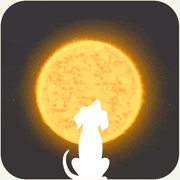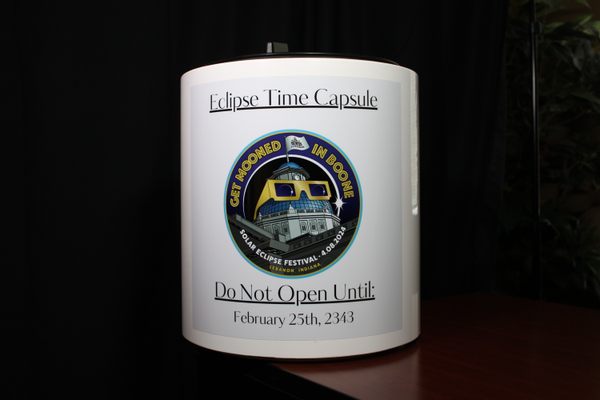7 Great Eclipse Books to Inspire, Delight, and Prepare You for April 8
From wild page-turners of the eclipse-obsessed to a gentle children’s book for all ages.
On April 8, when the skies darken across a ribbon of North America and our Moon swallows our day star during a total solar eclipse, look up. Definitely look up. (Wearing appropriate safety glasses, of course.) But until then, feel free to bury your nose in these brilliant reads about our closest celestial companion, that lump of rock in the sky that influences our world and inspires our art.
And if you run out of time before the big day to finish all of these wonder-filled books, have no fear. The next total solar eclipse visible from the Lower 48 is more than 20 years away. You’ll have plenty of time to prep.
Eclipse Chaser: Science in the Moon’s Shadow
by Ilima Loomis
This 2019 book is a must-read for fans of Atlas Obscura’s Scientists at Work tales from the field. Writer Ilima Loomis follows astronomer, physicist, and eclipse chaser Shaddia Habbal on her epic journey to study the Sun’s corona during an eclipse. Thwarted by clouds on a previous attempt, Habbal plans for the 2017 eclipse in meticulous detail—but will she find success? This page-turner captures the intensity—and joy—of scientific discovery.
A Few Beautiful Minutes: Experiencing a Solar Eclipse
by Kate Allen Fox and Khoa Le
As adults, we’re likely to process April’s big event in a number of ways: understanding the science behind it, comparing it to past eclipses we’ve seen, maybe even stressing out a little about whether we’ve arranged the best eclipse excursion possible. But children will likely experience the eclipse with a wide-eyed wonder that many of us have outgrown. That’s why we recommend this charming little book, intended for ages 4 to 8, regardless of how many trips around the Sun you’ve made. Kate Allen Fox’s gentle prose and Khoa Lee’s gorgeous, nature-focused illustrations can help us all appreciate this phenomenon with fresh eyes.


Our Moon: How Earth’s Celestial Companion Transformed the Planet, Guided Evolution, and Made Us Who We Are
by Rebecca Boyle
With the same thoughtful, often humorous writing you’ll find in Wondersky, her regular Atlas Obscura stargazing column, science writer Rebecca Boyle explores every nook and crater of the satellite that has had a surprisingly substantial influence on our planet. It’s quite possible we wouldn’t be here without the Moon, and Boyle delights in sharing both the science and storytelling behind humanity’s relationship with Earth’s sidekick.
American Eclipse: A Nation’s Epic Race to Catch the Shadow of the Moon and Win the Glory of the World
by David Baron
Now available in paperback, this award-winning read by former National Public Radio science correspondent David Baron takes us back to the summer of 1878. Parts of the American West were about to experience a total solar eclipse, an event with outsized significance for the nation: It was a chance for the United States to prove itself on the world stage of science. From an early-career Thomas Edison to astronomer Maria Mitchell and the young women she taught at Vassar—at a time when the field was very much a boy’s club—a curious cast of characters ventured west to witness the phenomenon. Baron tells their inspiring and sometimes harrowing stories with great attention to detail and a passion colored by his own love of chasing eclipses.

America’s First Eclipse Chasers: Stories of Science, Planet Vulcan, Quicksand, and the Railroad Boom
by Thomas Hockey
Almost a decade before the famous 1878 eclipse, the skies darkened over a very different United States. The total solar eclipse of August 1869 occurred in the heart of the Reconstruction Era, also an unparalleled time of expansion as the Golden Spike completed the Transcontinental Railroad earlier that year. Enter the heralded “coast-to-coast” North American eclipse, with a path of totality that stretched from the Outer Banks of North Carolina, across the Midwest and Rocky Mountains, all the way to Alaska. Writer and historian of astronomy Thomas Hockey takes readers into this turbulent period, which is credited with kickstarting American astronomy.
Mask of the Sun: The Science, History and Forgotten Lore of Eclipses
by John Dvorak
Writer John Dvorak spent years working for the United States Geological Survey as a geophysicist—including an assignment to monitor Mt. St. Helens in 1980—before turning his eyes to the sky. Grounded in science, he delves into the roots of many ancient superstitions and traditions around both solar and lunar eclipses, exploring why one culture’s omen of doom might be another’s celebration of good fortune.
Sun Moon Earth: The History of Solar Eclipses from Omens of Doom to Einstein and Exoplanets
by Tyler Nordgren
We’ve recommended this book before, as one of our top reads for the astro-curious, but astronomer Tyler Nordgren’s deep dive into our fascination with eclipses has never been more timely. Learn how our species has interpreted—and learned to predict—these phenomena, and how that knowledge serves as a springboard to understanding eclipses on other worlds, including those we might one day call home.
This story is part of Atlas Obscura’s Countdown to the Eclipse, a collection of new stories and curated classics that celebrate the 2024 total solar eclipse and the Ecliptic Festival in Hot Springs, Arkansas.






























Follow us on Twitter to get the latest on the world's hidden wonders.
Like us on Facebook to get the latest on the world's hidden wonders.
Follow us on Twitter Like us on Facebook